Masculinity in Korean Cosmetics Advertisements for Women
Main Article Content
Abstract
This research is a qualitative research. The objective is to study the image of the male being presented and constructed in the Korean cosmetic advertisement for women. Using the method of analyzing the Korean cosmetics for women advertisement published via online media during the year 2017 - 2018, specific to the 3 Korean cosmetics brands that using male artists to endorse the products as well as having official branches In Thailand. The selected brands are Nature Rebublic, with Korean artists is EXO. The Face Shop, with Korean artists is GOT7 and Innisfree, with Korean artist is Wanna One. And analyzing recipients with focus group and indepth interview general female consumers and female consumers who are fans of Korean artists.
The results of the study showed that the male models were constructed by 4 pattern, 1) Charming and natural 2) Warm and gentlemen 3 ) Confident men who are ready for various activities 4) Men with femininity. It is interesting to note that, that are constructed in Korean cosmetics advertising for women different from traditional image that is stereotyped by the society. The findings show images of men combine the new masculinity and the metrosexual angle at the same time, Advertising is trying to expand the line of cosmetic definitions that were originally restricted to women by making organics cosmetics belonging to all people (Unisex) who want to care for their own skin even men can use it even if the cosmetics are not identified as men's cosmetics.
The results of decoding showed that both of female consumers were able to deciphered the image of men in Korean cosmetics advertising for women very similar. Both of female consumers group recognize that the image of men in Korean cosmetics advertising for women is a man who good looking, warm, gentle, natural, not aggressive and cute like a women. While decoding on other issues there will be different depending on the level of fan club of the 3 male presenters.
Article Details
ข้อความและความเห็นในวารสารนิเทศศาสตร์และนวัตกรรม นิด้า เป็นของผู้เขียนแต่ละท่าน มิใช่ของคณะนิเทศศาสตร์และนวัตกรรมการจัดการ สถาบันบัณฑิตพัฒนบริหารศาสตร์
References
จินตนา ศุภศรีวสุเศรษฐ์. (2554). เครื่องสำอางออร์แกนิคมีจริงหรือ. วารสารอาหารและยา กันยายน-ธันวาคม 2554. กลุ่มควบคุมเครื่องสำอาง สำนักงานคณะกรรมการอาหารและยา.
ชัยณรงค์ เครือนวน. (2558). ปฏิบัติการและการต่อสู้ทางวาทกรรม ในการพัฒนาอุตสาหกรรม: ศึกษากรณีการพัฒนาอุตสาหกรรมภายใต้ตัวแบบมาบตาพุด. วารสารการเมิอง การบริหารและกฎหมาย ปีที่ 7 ฉบับที่ 2
ธีรพงศ์ เสรีสำราญ. (2555). ภาพสะท้อนของสตรีเกาหลีจากการสร้างตัวละครนำหญิงในภาพยนตร์ของ คิม คี ด็อค. วิทยานิพนธ์นิเทศศาสตรมหาบัณฑิต สาขาวิชาการภาพยนตร์ ภาควิชาภาพยนตร์และภาพนิ่ง คณะนิเทศศาสตร์ จุฬาลงกรณ์มหาวิทยาลัย.
ไทยรัฐ. (2560).เทรนด์ความงามใหม่ เน้น 'ลดใช้น้ำ-เครื่องสำอางเด็ก' ดัน SMEs สู่สากล. สืบค้นเมื่อวันที่ 29 มกราคม 2562 จาก https://www.thairath.co.th/content/859702
นลินทิพย์ เนตรวงศ์. (2559). ภาพตัวแทน “ผู้ชายในฝัน” ในละครโทรทัศน์แนวโรมานซ์. วิทยานิพนธ์วารสารศาสตร์มหาบัณฑิต คณะวารสารศาสตร์และสื่อสารมวลชน มหาวิทยาลัยธรรมศาสตร์.
นิธิ เอียวศรีวงศ์. (2538). “ผ้าขาวม้า,ผ้าซิ่น,กางเกงใน และฯลฯ ว่าด้วยประเพณี,ความเปลี่ยนแปลงและเรื่อง สรรพเพสาระ”. ศิลปวัฒนธรรมฉบับพิเศษ :111-118.
นิเวศ เหมวชิรวรากร. (2556). คนชั้นกลางรุ่นใหม่ The new middle class. สืบค้นเมื่อวันที่ 22 มิถุนายน 2562 จาก https://www.bangkokbiznews.com/blog/detail/489935.
นพวรรณ สุทธศิลป์. (2548). วิถีชีวิตหนุ่มเจ้าสำอาง. วิทยานิพนธ์มหาบัณฑิต สาขาสังคมวิทยา คณะสังคมวิทยาและมานุษยวิทยา. มหาวิทยาลัยธรรมศาสตร์.
ประภาพร ชินวงศ์. (2546). “Pretty boy:ปรากฏการณ์ความเป็นชายอีกรูปแบบหนึ่งในสังคมไทย. วิทยานิพนธ์มหาบัณฑิต คณะสังคมวิทยาและมานุษยวิทยา มหาวิทยาลัยธรรมศาสตร์.
ปณตพร พงษ์อนันตโยธิน. (2544). การเปรียบเทียบพฤติกรรมเผชิญกับปัญหาของผู้ใหญ่วัยทำงานที่มีบทบาททางเพศแตกต่างกัน. วิทยานิพนธ์ปริญญามหาบัณฑิต สาขาจิตวิทยาพัฒนาการบัณฑิตวิทยาลัย จุฬาลงกรณ์มหาวิทยาลัย.
ปรีชา เปี่ยงพงศ์สานต์. (2548). การนิยามชนชั้นกลางในสังคมไทย ใน ณรงค์ เพ็ชรประเสริฐ (บรรณาธิการ), ฅนชั้นกลางไทยในกระแสทุนนิยม (หน้า 145-173). กรุงเทพฯ: เอดิสันเพรสโปรดักส์.
พงษ์ศักดิ์ พุ่มประดิษฐ์. (2553). การรับรู้ภาพความเป็นชายในโฆษณาผลิตภัณฑ์เพื่อการดูแลตนเองสำหรับผู้ชายทางโทรทัศน์. วิทยานิพนธ์ปริญญามหาบัณฑิต จุฬาลงกรณ์มหาวิทยาลัย.
ภัทรพงศ์ คงวัฒนา. (2559) การศึกษาสัญญะความเป็นชายผ่านโฆษณาเครื่องสำอางผู้ชายในจีน. วารสารจีนศึกษา ปีที่9 ฉบับที่1. มหาวิทยาลัยเกษตรศาสตร์.
ไรอัน ปาร์ค. (2560). เมคอัพเกาหลียึดไทย สปริงบอร์ดสู่อาเซียน ชู2บิ๊กอีเว้นต์รุกตลาด. สืบค้นเมื่อวันที่ 10 กันยายน 2561 จาก http://www.thansettakij.com/content/145297..
ศิริกมล อธิวาสนพงศ์ . (2548). การถ่ายทอดอุดมการณ์ความเป็นชายผ่านหนังสือพิมพ์ไทยรัฐหน้า1. วิทยานิพนธ์ปริญญานิเทศศาสตรมหาบัณฑิต คณะนิเทศศาสตร์ มหาวิทยาลัยธุรกิจบัณฑิต.
ศูนย์วิจัยกสิกรไทย. (2561). ตลาดบิวตี้ยังแจ๋ว เกาะเทรนด์ธุรกิจทำเงิน. สืบค้นเมื่อวันที่ 29 มกราคม 2562 จาก https://1th.me/JuJ6.
สมสุข หินวิมาน. (2553). การสื่อสารกับสังคมแห่งความเสี่ยง Communication and Risk Society. วารสารวิทยาการจัดการ มหาวิทยาลัยราชภัฎเชียงราย.
สมสุข หินวิมาน. (2558). อ่านทีวีการเมืองวัฒนธรรมในจอโทรทัศน์. กรุงเทพฯ. พารากราฟ.
อภิญญา เฟื่องฟูสกุล. (2546). อัตลักษณ์ (Identity) การทบทวนทฤษฏีและกรอบแนวคิด, กรุงเทพฯ คณะกรรมการสภาวิจัยแห่งชาติ.
all kpop. (2017). Wanna One sign their first endorsement deal. Accesed on 21 March 2019 from https://1th.me/teP8.
Barthel, D. (1992). When men put on appearances: Advertising and the social construction of masculinity. Men, masculinity, and the media. Newbury Park : Sage.
Dyer, G. (1982). Advertising as Communication. Methuen & Co: London.
Voice TV. (2558). 'K-beauty' เทรนด์ใหม่ดังไกลในต่างประเทศ. สืบค้นเมื่อวันที่ 15 กุมภาพันธ์ 2562 จาก https://www.voicetv.co.th/read/156681.
Positioningmag. (2560). ส่อง 6 เทรนด์บิวตี้ปี 2018 "ลดใช้น้ำ-เครื่องสำอางเด็ก" มาแรง. สืบค้นเมื่อวันที่ 29 มกราคม 2562 จาก https://positioningmag.com/1117057.
pptv. (2558). EXO และแทยอน Girls' Generation ต่อสัญญาเป็นพรีเซ็นเตอร์ให้กับเเบรนด์Nature Republic อีกครั้ง. สืบค้นเมื่อวันที่ 21 มีนาคม 2562 จาก https://1th.me/kOOe
Strate, L. (1992). Beer commercial: A manual on masculinity. In S. Craig (Eds.), Men, masculinity, and the media. Newbury Park: Sage.
Stever, G. S. (2009). Parasocial and social interaction with celebrities: Classification of media fans. Journal of Media Psychology, 14(3).
Storey, J. (2008). Cultural studies and the Study of Popular Culture. 2nd ed. Edinburgh: Edinburgh University Press.
Thorne, S. (2011). An exploratory investigation of the theorized levels of consumer fanaticism. Qualitative Market Research: An International Journal, 14 (2), 160 – 173.
Wicks, D., & Mills, A. (2000). Deconstructing Harry: A Critical Review of Men, Masculinity and Organization. The Finish Journal of Business Economics, 49(3).


